Geoff Nicholson's Blog, page 62
February 15, 2012
LAUGHING TACKLE

Like many people, I try to model myself on Demi Moore, and if nitrous oxide is good enough to make her forget her worries, then it's good enough for me. My particular worry was that I was going to the dentist to have some awkward fillings replaced and since my man is of the new, caring breed of dentist, he suggested some nitrous would help me float away as he was doing all kinds of horrible things to my lower right molars.

The nitrous helped at least little, enough that afterwards I floated out of there not feeling quite competent to drive home, so I decided I should walk it off, and wander around the neighborhood streets for half an hour or so.
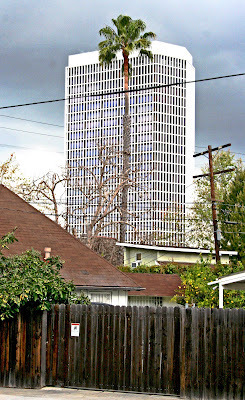
My dentist's office is on Wilshire Boulevard, and I'd been thinking about Ray Bradbury being picked up and interrogated by the cops for walking on Wilshire, though I can't say that's entirely why I decided to walk along 8th and 9th Street instead. And in fact I did see the cops pull somebody over on 8th Street – but he was in a car, so I guess that doesn't count.

Anyway, I'm here to tell you that nitrous oxide makes for a very interesting walk. I felt fine, if a little floaty, but everything around me seemed simultaneously very chaotic and also deeply fascinating; the sky, the palm trees, the building my dentist's office was in, the cacti in people's front yards, the parked cars, the gingerbread house roofs. Sometimes I can experience this without nitrous oxide, but I certainly hadn't been experiencing it that day before I went into the dentist.
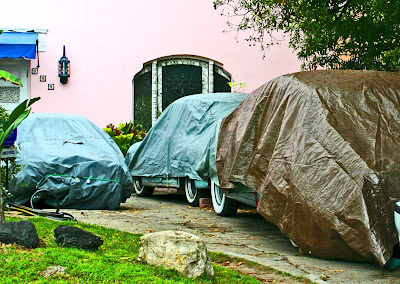
And then suddenly around a corner and there at the end of somebody's driveway a kind of hallucination: mountains, a moat, a fantasy castle. Hey man, this is good stuff!

And one thing I noticed was that a lot of the streets around my dentist's office share names with various pop or rock acts - Burnside as in (R.L. - who sings "Walkin' Blues"), Cochran (as in Eddie – singer of "Walk the Dog"), Detroit (as in Marcella of Shakespeare's Sister – "I walk past posters selling simple sex ooh!" from "Dirty Minds"). There were also a couple of near misses Cloverdale - not a million miles from Coverdale (David of Whitesnake "Walking In The Shadow of the Blues") and Dunsmuir, (somewhat like John Densmore of the Doors – "And then he walked on down the hall").

Even at the time it did occur to me that if your knowledge of pop music is wide enough you can probably think of somebody with just about any name, and most of them will have performed a song with walking in the title or the lyric. Still, at the time, it seemed somehow very significant.
Eventually I felt fit enough to drive. I finished the walk, went back to the car, got in, started the engine, and what do you think was playing on the radio? "Careless Whisper" by George Michael. Yep, the nitrous was good and gone.


Published on February 15, 2012 15:08
February 14, 2012
HOLLYWOOD, MECCA OF PEDESTRIANS, AND CLICHE-MONGERS

It probably amazes me even more than it does you, but there was an occasion last year when I found myself at a party, sitting at a table between Werner Herzog and T-Bone Burnett. Or to put it another way, between the man who wrote Of Walking In Ice and the man who put together the soundtrack for the movie Walk The Line.
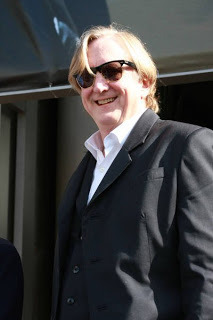
Herzog's work I knew reasonably well, Burnett's not so much, although I was aware he'd been part of Dylan's Rolling Thunder Review and was involved with the music for O Brother Where Art Thou. He seemed a cheery man, rather more so than Mr. H, and when I got home I did some research on him.
I found an interview with Los Angeles magazine in which he said that after more than twenty-five years of living here, "I love Los Angeles, even though in some ways I feel like I barely know it. Hollywood I felt like I knew before I even got here." Which is a feeling a lot of us have.
I also found a great song of his titled "Hollywood Mecca of The Movies." I'm sure you can find it on youtube, or you could even buy it. It's a pretty great song: big spacious percussion, lean guitar by Marc Robot, and Burnett delivering more or less spoken lyrics that include the lines:
It's a mortal cinch, No resilienceWe didn't build this place to last foreverWhat A Town, What A Great Town
Only afterwards did I learn that Hollywood Mecca of the Movies was also the title of a book by Blaise Cendrars, originally a series of newspaper articles written in 1936 for the newspaper Paris-Soir. The song is way better than the book, if you ask me. Though when it comes to snappy dressing, I think M. Cendrars is probably the winner.
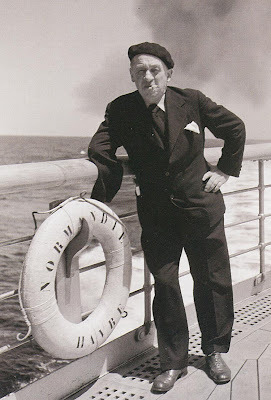
Cendrars was in town for just two weeks, seems to have met almost nobody, and ended up relying on every cliché in the book. Maybe he felt like he knew the place before he even got here. The sun shines but everyone's unhappy, Hollywood is an "illusion factory," writers are treated with contempt, talent scouts are "birds of prey." And, all too inevitably, he writes a chapter titled "In Hollywood, anyone who walks around on foot is a suspect." (Can anyone walk around other than on foot? Though I suppose we might have to blame the translator for that one.)
He describes staying in the Roosevelt Hotel on Hollywood Boulevard, from which he goes for a walk after midnight. A large black car pulls up, two cops jump out and grab him by the arms. They ask his name. For unimaginable reasons he says Roosevelt though they don't seem to object to that. I would have. Then they bundle him into the car and deposit him "a few hundred feet ahead of my hotel."
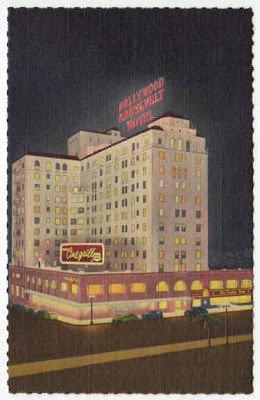
Next morning he tells the story to his friends who explain that it happened "because it never occurs to them (the cops) that one might walk in a city like Hollywood, where there are more cars than people!" They also say he was lucky the cops didn't beat him up, which is the only part of the story that seems remotely credible to me.

John Paul Jones of Led Zeppelin has a similar story, but I think he got picked up because he was jaywalking as opposed to simply walking; jaywalking being a concept pretty much unknown in Britain.
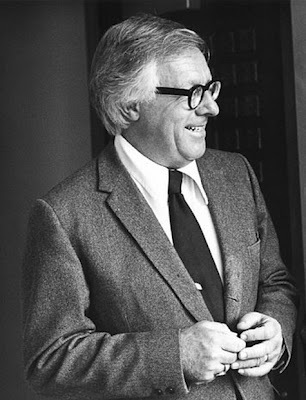
And of course there's the short story by Ray Bradbury titled "The Pedestrian" about some future non-walking society in which our hero wanders the streets at night and is picked up by a robot police car and sent to the "Psychiatric Center for Research on Regressive Tendencies." Bradbury claimed he wrote the story after being stopped and interrogated by cops as he was walking innocently on Wilshire Boulevard.
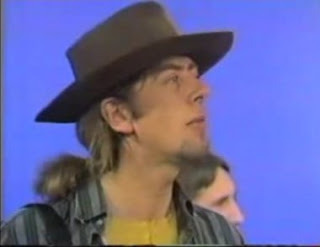
How refreshing then to come to John Mayall, he of Bluesbreakers fame. Mayall was, I suppose still is, an Englishman who went native in LA in the late 1960s. His album Blues From Laurel Canyon contains the song "Walking on Sunset." Again, you could buy it if you wanted. It has some pretty ropey lyrics, including:
The cops are in the cars but they never bothered meA new magic world where I never felt so freeI'm walking on sunset, well I'll never reach the endI'm walking on sunset, everything is like a friend.
Well this strikes me as, at best, a slightly naïve response – I have seen many things on Sunset that didn't look remotely like a "friend," still at least he's not just repeating the received opinions about walking in LA. Good for him. Good for all of us.


Published on February 14, 2012 16:21
February 4, 2012
ABIDING ON SUNSET
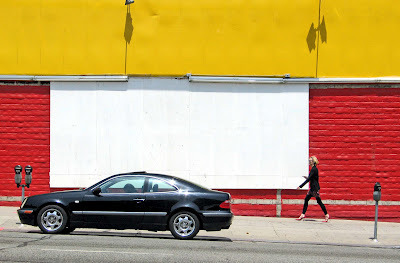
Unlike a lot of walkers I am not especially anti-car. Oh sure, when they almost run me down then I feel outraged and antagonistic toward the drivers, but I feel just as outraged and antagonists towards pedestrians who try to shoulder me off the sidewalk.
When I first moved to Los Angeles certain people back in England asked me why, what was the attraction? I always thought it was one of those "If you have to ask then you're never going to know" type questions, and I replied (only a little flippantly), "Well, if you like quirky architecture, exotic flora and fauna, and cool cars, where else are you going to go?" This, admittedly, did not convince anybody who wasn't already prepared to be convinced.
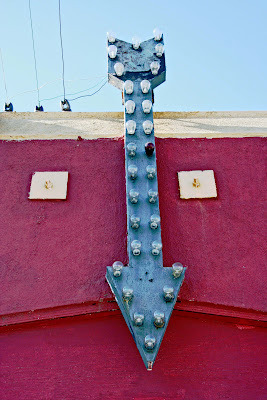
Wherever I walk I always look at the environment around me, and since I do much of my walking in cities, and most of that in LA, I inevitably see a lot of cars. Since they're there I figure I might as well appreciate them. Shiny new cars don't do much for me, but give me a car with a certain amount of patina and a hint of ruin, and I'm in aesthetic heaven. Hell, I'm even likely to take a photograph.
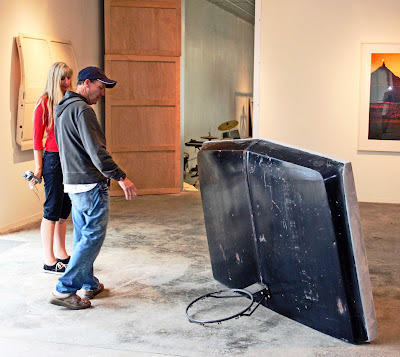
There was one day after I'd spent a weekend looking at a lot of art by Richard Prince – the stuff with with cars and body panels – when suddenly there seemed to be Richard Prince works of art on every street corner. This is surely one of the defining qualities of great art, that there are times the when whole world looks like it's been created by the artist.
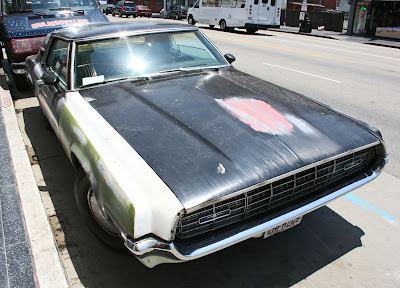
Still, when I first arrived in LA, however committed I was to walking, it became obvious that I really couldn't live here without a car. I didn't want a brand new car, and I didn't want to deal with a used car salesman, so I developed a plan. I would walk the streets of LA and the right car would present itself to me. I'd be walking along and I'd see a car with a "for sale" sign in the window and that would be "my" car. Which is why I ended up as the owner of a 1966 Dodge Dart that was parked in the street half a mile away from where I live.
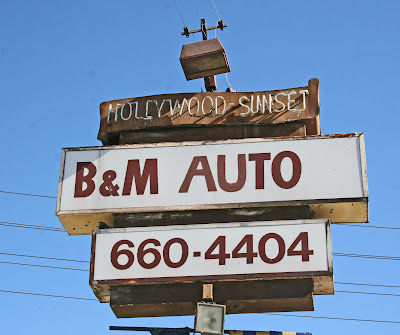
In fact there was one car dealer's lot that did vaguely attract me. It was called B&M Auto, located right at the place where Sunset and Hollywood Boulevard's converge. It was a slightly scruffy, down at heel operation, but they always had some interesting cars for sale, say a Mustang resprayed an improbable yellow, a Jeep Wagoneer, or an E type Jag with a dent in every panel, that kind of thing.
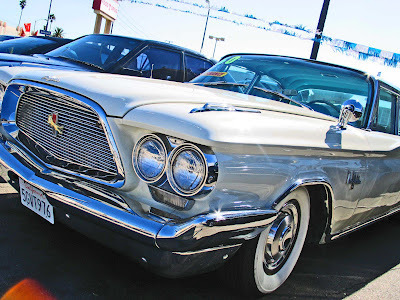
Of course I wouldn't have felt completely confident buying an E Type Jag with a dent in every panel from a slightly scruffy, down at heel operation, and I suppose that's why I didn't. But any time I walked around the area I always looked at what they had for sale and I'm not saying I thought it would B&M Auto always be there – there was always a provisional feel about the place - but even so it came as a blow to walk past the lot last weekend and find all the cars gone.
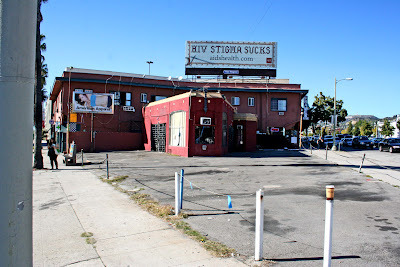
The office was empty, there was a sign up in the window saying that B&M Auto was no more and that a new tenant had been found for the premises. There was something deeply melancholy about the change, and the absence.
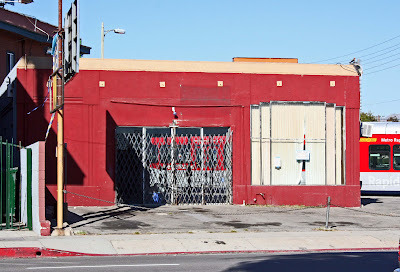
I don't want to make too much of the "change and decay in all around I see" business, but I've now lived in LA long enough that quite a few things I liked have gone. Many a soulful building or landmark has been demolished, this Bob's Big Boy and the very mid-century Cadillac dealership beyond on Wilshire, for instance.
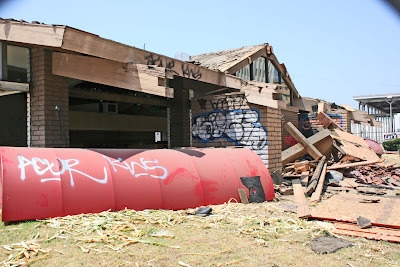
Just a few weeks back they took away the giant hot dog that stood at the corner of Hollywood Boulevard and Western Avenue. Well frankly that one always seemed doomed. The surprising thing here was that it lasted so long. I wonder if somebody bought it to preserve it. For that matter I wonder if somebody's going to buy the B&M Auto sign.

So, in a world of civic and architectural uncertainty the statue of Rock and Bullwinkle that stands at 8218 Sunset Boulevard seems a touchstone of stability and continuity. It's outside what used to be the Jay Ward headquarters and gift shop, now a dog grooming parlor. The statue first appeared in 1961 – Jayne Mansfield was there at the unveiling – so it's been standing over 50 years. In Hollywood terms that makes it as historic and permanent as the statuary of ancient of Rome.
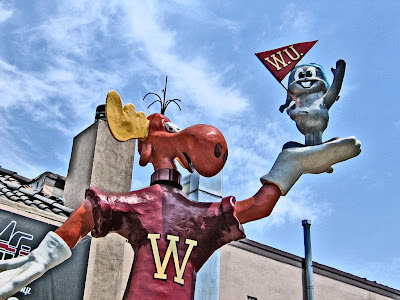
And you can say this for the custodians of Bullwinkle, they're not letting him turn into a ruin. Every now and again bits of him fall off, including his hand at one point apparently, but fortunately LA has the kind of skilled artisans you can call up and ask to come over and repair your Bullwinkle statue. You try doing that in the Eternal City.
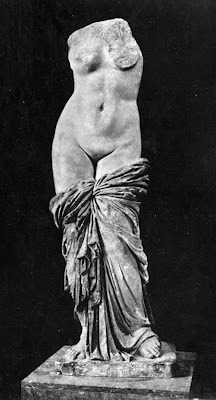

Published on February 04, 2012 16:43
January 24, 2012
THE WALKING MAP

Like a lot of walkers I'm a big fan of maps. When I went abroad for the first time, in my teens, to Nancy in France, to work on a pretty dubious "international youth project," one of the first things I did was buy a map of Nancy so that I could go walking and know where I was. The rest of the international youth thought this was very odd of me. As you see I still have it.
Later, when I first moved to London, straight after college, of course I owned a London A-Z, more of a book than a map, and I carried it with me all the time: I wanted to know where I was, I wanted to know how to get where I was going. This didn't strike me as odd in the least.
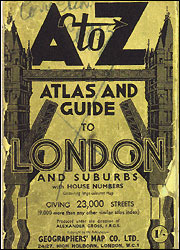
I was living in London because I'd got my first real job, working for a company named Bertram Rota, that dealt in twentieth century literary first editions, as well as authors' manuscripts and the occasional item of literary memorabilia.
One of the company directors was George Lawson, a dapper, twinkly man of Scottish origins who was extremely well-connected, and never seemed to do anything that looked like work. He'd just mess around in the store most of the day, but at some point he'd pick up the phone, call somebody important, and make a fabulous deal that earned the company a small fortune. He was friends with all manner of people in the art and literary worlds, not least David Hockney, who was a regular visitor to the store, and painted a rather wonderful portrait of George and his boyfriend – the ballet dancer Wayne Sleep.
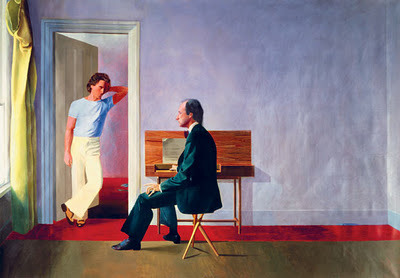
On one occasion George saw that I kept an A-Z in my bag. "So," he said, "do you mean to say that when you go around London you take a MAP with you?" I said that I did. He found this both strange and hilarious. And my reaction at the time was, "Doesn't everybody?" Surely, I thought, nobody knows the whole of London, and if you stray anywhere outside your usual orbit you're going to need a map, aren't you? London is this vast and intricate city, how could you get around without one?
I didn't say that to George, and in retrospect I'm glad that I didn't, and of course once I'd lived in London for a while I didn't carry an A-Z with me all the time. And that's surely how it always is once you know a city. I didn't know every street, didn't have a complete map of London imprinted in my head, but I'd developed a feel for the place, had a general sense of direction, a sense of how neighborhoods related to each other. This was based on the experience of walking, of knowing the city on the ground, not on a map, and of course there were occasions when I went to some completely unknown part of the city, in which case I dug out my old A-Z.
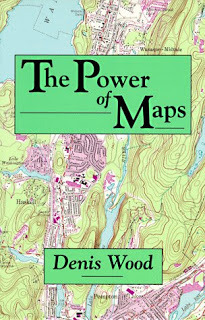
The latest copy of the Believer has an interview with Dennis Wood, author of the "Power of Maps" and now "Everything Sings: Maps for A Narrative Atlas." He talks about the idea that street signs and names are only for strangers: when a place is part of you, you don't need a street sign telling you where you are. He obviously has a point. Then he says, "You get to a new city and you leave the hotel, you've got two hours before something happens, so you just wander around. You don't pay any attention to the name of the streets, but you conserve a memory of turning left or turning right, or some landmark. You don't need to know the names." This is obviously true too, and a familiar enough experience, but there's a contradiction here, isn't there? This is surely an example of a situation where the signs and the street names aren't for strangers: or at least the stranger in this case isn't paying any attention to them.
It also raises the question of how far away from home you have to be before you're considered as a stranger. Unless you always stay within an incredibly limited number of streets then sooner or later you'll find a street sign extremely useful.
Actually, I also wonder how just how many people spend two hours walking the streets around their hotel these days. I do, of course, and obviously I'm not the only one (the Believer has an article by Daniel Handler that says he does it too), but I suspect a lot the people who arrive in a new city and want to get some exercise are more likely to go to the hotel gym or the pool, rather than walking the streets. So much modern "travel" seems to involve spending time in luxury resorts and spas, being pampered, staying in a bubble, rather than going out and exploring some place you've never been before.
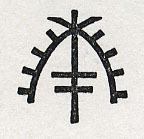
Meanwhile, back at Bertram Rota, there was an occasion when we were selling some Somerset Maugham memorabilia, including his walking stick. I imagine it may have been one of many, but it was an impressive thing, embossed with the Maugham "hand of Fatima" symbol to ward off the evil eye.
George Lawson spent most of one day pretending to have a limp, hobbling up and down the shop, using Maugham's walking stick for support. He was very convincing, and customers who knew him showed considerable concern and asked how he'd come to injure himself. He found this even more hilarious. I wish I could say that David Hockney had come into the shop in the middle of George's act, but that really would be too neat.

For one reason or another I've been rereading "David Hockney on David Hockney," his autobiographical book from the 1970s, now subtitled "My Early Years". Back then at least he was the kind of man who liked to wander the streets around his hotel, in this case in Santa Monica rather than Los Angeles proper.
He writes, "I checked into this motel and walked on the beach and I was looking for the town, couldn't see it. And I saw some lights and I thought, that must be it. I walked two miles, and when I got there all it was a big gas station, so brightly lit I'd thought it was the city. So I walked back …" I guess if he'd had a map he'd have known better.
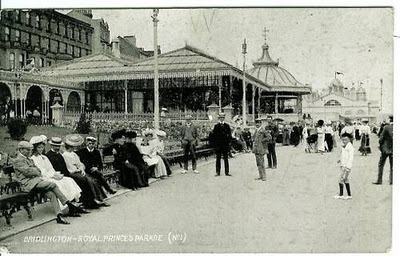
Hockney comes from Yorkshire of course, as do I, and after decades in L.A. he's back there living in Bridlington (he has his reasons). Bridlington exists in my imagination as a place of utter, rain-drenched gloom, a place of family day trips where we gamely walked up and down the prom, under grey skies, through the drizzle. We'd driven all that that way, we weren't just going to sit in the car.
Anyway, David Hockney seems to be very happy there in Bridlington, is painting up a storm, having a major retrospective at the Royal Academy and is in some danger of becoming an English national treasure. Evidence suggests that he's doing quite a bit of walking too. The blog for Time Out, London recently did a piece titled, "Take A Walk With David Hockney." Here's a picture of David Hockney walking past a painting by David Hockney.
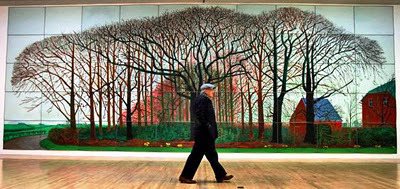

Published on January 24, 2012 08:39
January 18, 2012
THE THINGS YOU SEE ...
And speaking Bronson Canyon (as I was when discussing walking to the Batcave), yesterday afternoon a severed head was found there.
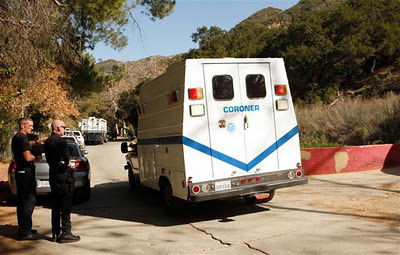
Of course we all occasionally find strange things when we're out walking. I once found a large knife by the side of the road, big ugly blade, handle wrapped in duct tape. It looked a lot like a murder weapon. I still have it: comes in handy once in a while.
There's a Will Self column where he talks about finding a red plastic dildo while on one of his walks, and my friend Joanna Moriarty claims to have found a finely carved wooden dildo while out walking, on vacation in Germany. She didn't bring it home with her, which strikes me as a mistake. Certainly it used to be pretty common to find dirty magazines while out walking, stashed in hedges or behind walls, presumably by people who for one reason or another were unwilling to have them in the house. That seems to happen a lot less these days: I blame the internet.
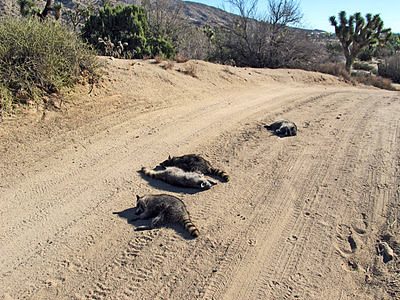
And of course you see dead animals all the time. I was out for a walk one morning in Yucca Valley and I came across this row of dead raccoons. I don't know how they were killed: they didn't seem to have a mark on them, and although I know raccoons can be pests, I'm not sure I could easy kill one.
And of course when you're out walking in the city you regularly see guys lying around in the street unconscious, and you assume they're drunk or drugged, but you do sometimes wonder if they might be dead.
This afternoon they found a couple of severed hands and feet to go along with the head in Bronson Canyon, and the current thinking is that the person wasn't killed and dismembered in the park: the deed was done elsewhere, the park used as a convenient dumping ground. This is somehow reassuring.
The severed head was found by a couple of professional dogwalkesr: dogs just love the scent of human remains it seems, and I suppose that's why you so often read about bodies and body parts being found by people walking their dogs. In more out of the way places such finds are more usually attributed to "hikers." Just once I'd like to read that "the body was found by a psychogeographer" or "the severed head was discovered by a flaneur." I guess I'm just going to have to get out more.


Of course we all occasionally find strange things when we're out walking. I once found a large knife by the side of the road, big ugly blade, handle wrapped in duct tape. It looked a lot like a murder weapon. I still have it: comes in handy once in a while.
There's a Will Self column where he talks about finding a red plastic dildo while on one of his walks, and my friend Joanna Moriarty claims to have found a finely carved wooden dildo while out walking, on vacation in Germany. She didn't bring it home with her, which strikes me as a mistake. Certainly it used to be pretty common to find dirty magazines while out walking, stashed in hedges or behind walls, presumably by people who for one reason or another were unwilling to have them in the house. That seems to happen a lot less these days: I blame the internet.

And of course you see dead animals all the time. I was out for a walk one morning in Yucca Valley and I came across this row of dead raccoons. I don't know how they were killed: they didn't seem to have a mark on them, and although I know raccoons can be pests, I'm not sure I could easy kill one.
And of course when you're out walking in the city you regularly see guys lying around in the street unconscious, and you assume they're drunk or drugged, but you do sometimes wonder if they might be dead.
This afternoon they found a couple of severed hands and feet to go along with the head in Bronson Canyon, and the current thinking is that the person wasn't killed and dismembered in the park: the deed was done elsewhere, the park used as a convenient dumping ground. This is somehow reassuring.
The severed head was found by a couple of professional dogwalkesr: dogs just love the scent of human remains it seems, and I suppose that's why you so often read about bodies and body parts being found by people walking their dogs. In more out of the way places such finds are more usually attributed to "hikers." Just once I'd like to read that "the body was found by a psychogeographer" or "the severed head was discovered by a flaneur." I guess I'm just going to have to get out more.

Published on January 18, 2012 18:01
January 13, 2012
NOR IRON BARS ...

When you got into the sixth form at my otherwise less than enlightened English grammar school, you were allowed to go outside the school grounds at lunch time: all kinds of punishments were meted out to younger boys who failed to stay inside the boundaries.
This sixth form freedom felt pretty good, sometimes it felt like a prison break, though I can't say it was used very excitingly. We went and bought sandwiches at the local shop, and I'm sure some bad lads slipped away to smoke, although to be caught smoking outside the school grounds was every bit as grave an offence as being caught smoking inside the school grounds.
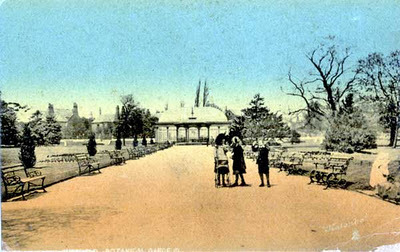
I wasn't a smoker anyway, and many of my lunchtimes were spent wandering – my mother would have called it "mooching" - around the nearby Botanic Gardens. Botany and gardens were predictably less than fascinating to a 17 year old boy, but I do remember being intrigued by a large circular pit on the south side of the gardens. It was maybe 25 feet across, and maybe 15 deep, the walls lined with antique masonry, and there were railings around the top to stop you climbing or falling in.
We called it the bear pit, though I don't think we actually believed that bears had ever been kept in it. We were wrong. I now discover that bears were indeed kept there in the nineteenth century, from 1836 to some time in the 1870s. Incidentally, bear baiting was outlawed in England in 1835, so I suppose this was built as a kind of retirement home for bears whose baiting days were over. The pit was closed after a child fell in and was killed. The Botanic Gardens website doesn't say whether the child was killed by the fall or by the bears, but you've got to hope it was the former.
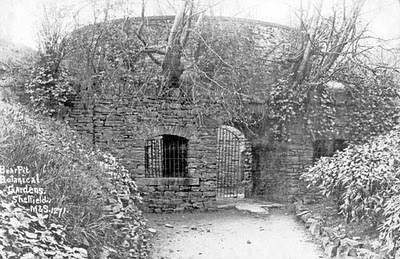
Some years back, on a return visit to Sheffield, I walked around and around the Botanic Gardens trying to find the bear pit again, and I absolutely couldn't. I was torn between thinking that perhaps I'd imagined its existence and there'd never been a bear pit at all, while also thinking on the other hand that perhaps it had been filled in, erased from history in the interests of political, or I supposed zoological, correctness. I was evidently wrong again.

The bear pit is still there, and has been refurbished as part of the gardens' entire restoration. You can now walk into it, and it contains a statue of an improbably benign-looking bear, who remains unmoved however much you bait him. Actually, to me, he looks more like a man in a bear suit, but in a country where there have been no wild bears for about a thousand years, the sculptor might be forgiven for getting the anatomy a little wrong.
The last wild grizzly bear in California was killed in 1922, some 6 years after the last one in LA county. Black bears we've still got, and at one of the southern entrances to Griffith Park we also have a bear statue. He too gets anthropomorphized from time to time, for instance being dressed up as Santa Claus or decked out in a Lakers uniform, depending on the season.

For that matter there are even live bears in Griffith Park, since on the north eastern corner it contains the LA Zoo, a place I go once in a while because my wife is an animal lover. It's fine as far as it goes, but a visit there seems ever more to resemble a walk around a gigantic food court that happens to have a few animals thrown in – the Gorilla Grill, indeed - but that's another story.
Far more intriguing, if essentially animal-free, is the old abandoned zoo nearer to the center of Griffith Park. It's been listed by the website Weburbanist.com as a place of "Amazing American Abandonment" which strikes me as overstating the case, but undoubtedly it is a great and surprising place to wander around.
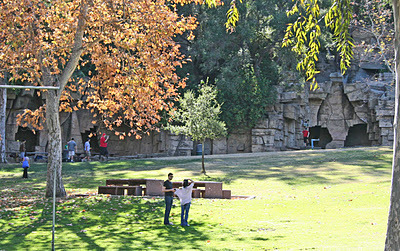
As sites of amazing abandonment go, it's remarkable easy to access. There's plenty of parking nearby, a children's playground, public toilets, and you'll see people having picnics and playing frisbee right outside, and sometimes even inside, the ruins. And that's one of the interesting things: some people in the park simply ignore the old zoo structures, and maybe they don't even see the cages and the bars and the fake rocks, while others seem completely bewitched by them.
The zoo was actually founded in 1912, but most of the cool features were built by the WPA in the 1930s. The less cool features make it look like a hideous animal prison. The authorities address this by posting notices that say, "although these historic enclosures are no longer appropriate for housing animals, they can be home to memories of family visits .." blah blah. Of course it's those words "no longer" that seem especially uncomfortable to a modern sensibility. Surely, we think, these enclosures were never appropriate for housing animals. The place closed in 1965.
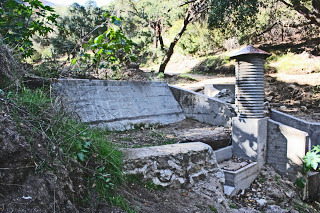
There's something inscrutable about many of the old structures. You have to guess what they were and which animals were housed in which: was this a monkey house or an aviary or a cage for big cats? What animal needed bars as thick as some of these, and were visitors really able to get as close as it now appears?

In that sense, the experience is not so different from exploring any set of ruins anywhere. It's a little like going to Pompeii and trying to work out which was the thermopolium, which was the macellum, though in the case of the old Griffith Park zoo, there's no map or guide book to direct you, and I haven't been able to find one, but I'm still working on it.

The most striking and easily identifiable structures in the old zoo are referred to as the bear grottoes, a rather more poetic, in fact euphemistic, way of saying a bunch of pokey, gloomy manmade caves that look like a movie set, and have in fact been used as one. The great attraction here is that you can actually go inside, climb on the rocks, pad along the shadowy passageways, press your snout against the gates and the bars. You can have the, admittedly anthropomorphic, experience of feeling what it must have been like to be a caged animal: pretty goddam awful, obviously.
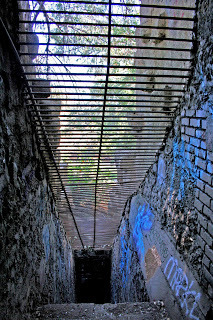
A lot of people have certainly been in there before you. Certain parts of the grotto interiors have been turned into a kind of graffiti palace, most of it inevitably ugly and depressing, much of it just tagging. There was even one golden oldie, though it looked pretty fresh, tagged El Barto: Matt Groening must be so proud.
Still, one or two areas are eerily compelling, including the dark, dead end corridor (below), which rests in complete darkness unless you have a flashlight with you, or shoot it with your on-camera flash. And yes that Frankenstein head at the top really is luminous.
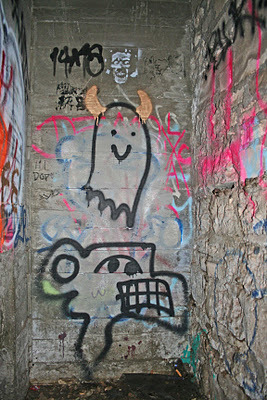
Actually it's remarkably difficult to find pictures of the zoo before it was abandoned. This one is from the LA Public library collection, dated July 13, 1959:
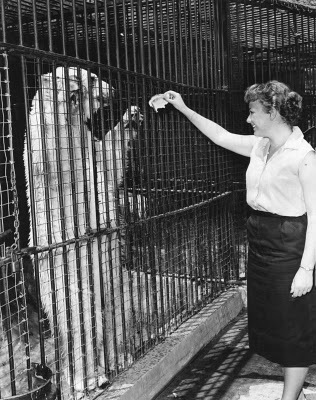
The caption reads, "Visits Children's Friend -- Gail Petersen, the 15-year-old Van Nuys student, visits Griffith Park zoo bear she named to win contest which will send her, her parents, and two friends across the polar ice cap to Denmark to visit relatives and tour Europe as guest of SAS [Scandinavian Airlines]." Clearly this bear is not in one of the grottoes, and even if this shot was setup solely for the benefit of the photographer, you have to think young Ms. Petersen was lucky to go home with a full set of fingers.
You might come away from the zoo thinking, well OK, we've made some kind of progress. We've become more compassionate, more caring about our non-human fellow creatures. Nobody today would ever dream of housing animals in conditions like this. And yet, as I climbed up a set of stairs inside one of the grottoes and looked out through the chain link opening at the top, I spotted a couple of guys hanging out on the other side. I didn't think anything of it at first. I assumed they were just other visitors to the park, which they were, though of a rather specialized kind.

After I came out of the grottoes I walked around the other side, the service entrance as it were, and there were the two guys again. I could see them better now, young, healthy-looking, a Rasta and a hippie, and they'd made a camp right there at the rear end of the grotto, they were living there, behind the chainlink, invisible to passersby, though exposed to the view of the occasional pesky, low-level urban explorer who poked around in the bear grottoes. These zoo structures might not be considered "appropriate" habitation for animals anymore, but obviously they were quite appealing for certain human beings.
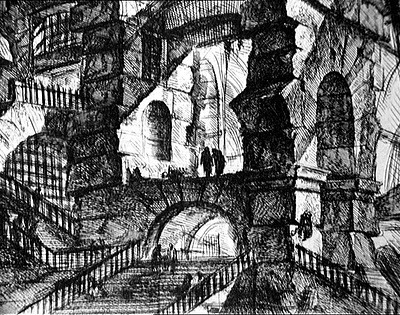

Published on January 13, 2012 18:08
December 28, 2011
WALKING WITH CATWOMAN

Hollywood being what it is, I found myself shortly before Christmas at the same party as Julie Newmar, the legendary actress who played Catwoman in the Adam West Batman TV series of the early 1960s. That's her above at the party. As I've discovered since, having mentioned it to various people, there are some who find this the most exciting thing they've ever heard, others who haven't a clue who the lady is: generation has something to do with it, but not everything.
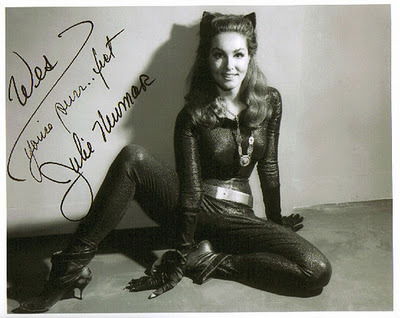
Ms. Newmar and I exchanged a few pleasantries, and I did notice that she was a little unsteady on her feet, holding people's arm for support, and I did hear her tell somebody that she gave up high heels about five years ago. There's much debate online about just how old Julie Newmar is, but nobody seems to think she's less than 75, so to have been strutting in stilettos till the age of 70 doesn't strike me as the worst record. And whatever age she is, she's still looking pretty damn good on it.
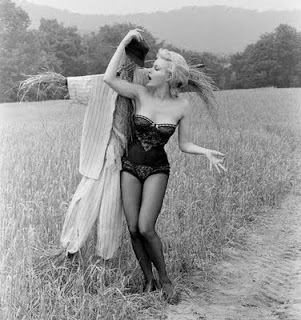
In fact it's not easy to find a picture of Julie Newmar walking, whether as Catwoman or as herself: photographers seem to have preferred to see her lounging around. I don't really blame them. The day after the party I looked up her blog and found an entry from 2009 titled Up and At 'Em, in which she tells us that sadly "The crunch is, I barely can walk these days," but not to worry, she says, "I can fly … Flying is the key. As a concept, flying beats walking any day. In my case, it means walking intensely, as in an intensity of purpose."
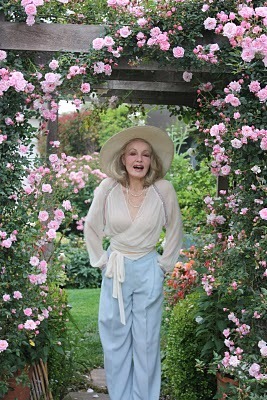
She also compares herself with Franklin D. Roosevelt (not a comparison many of us would make, I think), "Like me, Franklin Delano Roosevelt couldn't walk, and he rose above it to run the United States of America for four terms as President. We never heard him complain." Indeed.
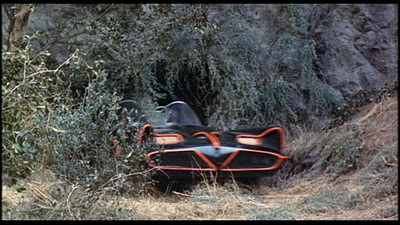
Now, it so happens that I live within walking distance of the location used as the outside of the Batcave in the 1960s TV series, it's in Bronson Canyon, which is itself part of Griffith Park. In fact, the Batcave isn't really a cave at all, it's a short tunnel, the remains of quarrying work that used to go on in the area. The interior, of course, was elsewhere, in fact on a sound stage at Desilu Studios in Culver City.
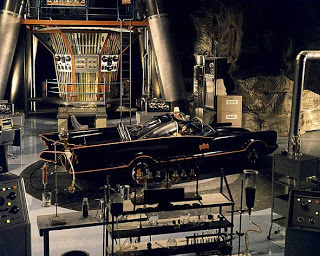
Nevertheless, in honor of Batman and Catwoman, and especially in honor of Julie Newmar, I decided to walk up there on Christmas Eve and found that a surprising number of people had had the same idea. Good for them. Good for all of us.
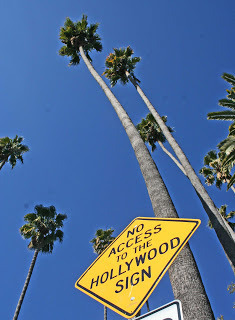
The walk started at the corner of Foothill Drive and Canyon Drive, another of those frustrating roads posted with the message "No Access to the Hollywood Sign," the truth being that no road actually gives access to the Hollywood sign, however we define "access."

Along Canyon, it being Xmas, a few people had decorated their gardens, including the one above, fine of Christmas balls adorning a euphorbia and a century plant. Not far from here, not that long ago, one of the house where they once had a full size cross outside, big enough for a real crucifixion, which I guess is another version of the Christmas story. Eventually the walk took me into the park with its various signs warning against fires and rattlesnakes, and this particularly fine sign forbidding alcohol.
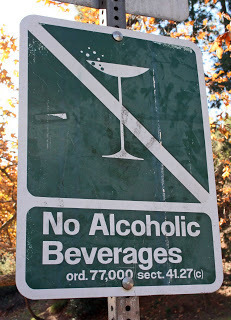
Now admittedly that's a very shallow glass out of which to drink booze, but those bubbles sparkling both in and out of the glass strike me as a triumph of alcohol-related design, though frankly not one likely to deter the determined boozer/walker.

Access to the "Batcave" is on foot only and there's a locked barrier across the track leading up to it, to prevent vehicles entering, but once you get up to the cave there's evidence that bad boys have found a way to drive up there and have done doughnuts in front of the cave entrance.
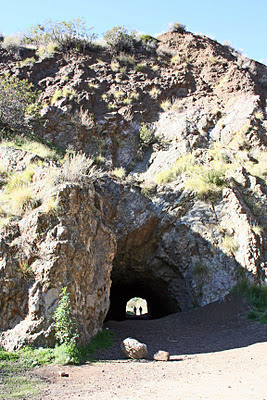
Of course there are no bats in the Batcave, let alone cats, and their attendant men and women, but once you emerge on the other side there are ravens on the hills and hawks circling, and if you turn to the left and look up you do actually see the Hollywood sign, rather distantly, which is arguably the best way to see it.
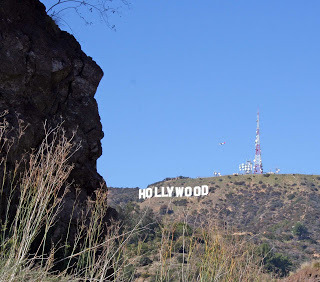
I'm not sure that Batman did much more walking than Catwoman or Julie Newmar but there is this great cover for detective comics. "Beware of Batman, he's a walking bomb." Aren't we all?
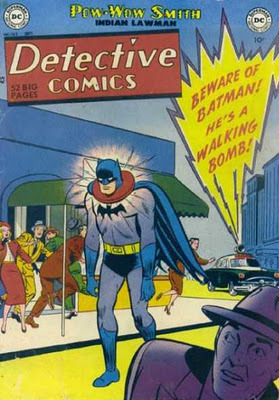

Published on December 28, 2011 09:08
December 24, 2011
3 SCENES FROM THE LIFE OF AN OCCASIONAL DESERT WALKER
[image error]
ONE: The Trona Pinnacles are one of the most exotic yet most seen bits of landscape in America. They look truly extraordinary but they regularly appear in car commercials and have been in all manner of SF movies, not least Lost in Space and the Tim Burton's Planet of the Apes.
We went walking there and for several hours were pretty much the only people around for several hours although there was one terrible moment when we first arrived and I'd parked in what I thought was a nice isolated spot, when a minivan pulled up about ten yards away. Since the area covers nearly 4000 acres this seemed an unnecessary intrusion, but perhaps the driver saw me, thought there's a desert hound who obviously knows the perfect spot and decided to join me. Fortunately not for long. In this case, the passenger, a pleasant enough middle-aged woman got out of the car, raised her camera, took a single photograph and got back in the car and drove away. The woman's desert walk had covered maybe twelve feet.
[image error]
But then at sunset three or four cars arrived, each one driven by a single man, and every one of them got out, walked to an isolated spot and sat there silently and alone till the sun went down. These are the kind of desert walkers one appreciates.***
TWO: I drive a Jeep, not because I want to prove myself in some manly way by cresting rocks and swamps, but because I want to go walking in places an ordinary saloon won't take me. I know that in Death Valley people thrash their saloon cars over some nightmarish terrain, but I assume these are rental cars. And I was certainly glad to have a four wheel drive on the road to the ghost town of Skidoo where the below picture is taken.
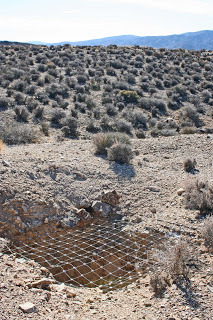
Skidoo was once a mining town and although there's not much sign of a town anymore, the hills are scattered with mining debris and open shafts, their entrances fenced, but I'm sure you could fall in if you were really determined.
I always find it strangely satisfying to walk a couple of miles into the hills and look then back the way I've come and to say to whoever's with me, "Hey, I can see my car from here." There it is on the far left, with the arrow.
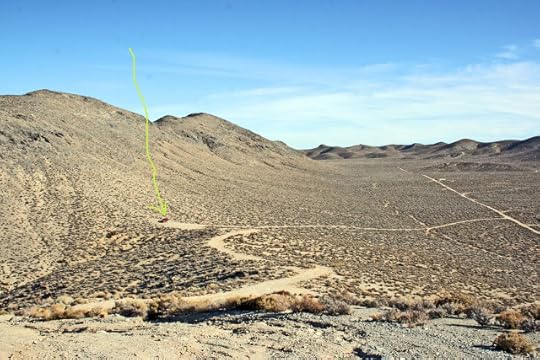
Of course I always some anxiety that I'll look down and see some bad seed has arrived, broken into the car and is now stealing my stuff. So far this has never happened, but there's always a first time.
***
[image error]
THREE: And speaking of feral furniture, we did of course find some wrecked TVs and sofas on our desert travels – in some cases they were inside trailers that had themselves been wrecked. The picture above is taken in Trona.
And the one below was the best score of all – also in Trona – a wrecked house the railway line and the chemical factory, and inside along with a derelict sofa and fridge, there was a piano (or at least half a piano.). Here is a picture of my desert walking companion, walking on a piano. Does it ever really get any better than this?
[image error]
***

ONE: The Trona Pinnacles are one of the most exotic yet most seen bits of landscape in America. They look truly extraordinary but they regularly appear in car commercials and have been in all manner of SF movies, not least Lost in Space and the Tim Burton's Planet of the Apes.
We went walking there and for several hours were pretty much the only people around for several hours although there was one terrible moment when we first arrived and I'd parked in what I thought was a nice isolated spot, when a minivan pulled up about ten yards away. Since the area covers nearly 4000 acres this seemed an unnecessary intrusion, but perhaps the driver saw me, thought there's a desert hound who obviously knows the perfect spot and decided to join me. Fortunately not for long. In this case, the passenger, a pleasant enough middle-aged woman got out of the car, raised her camera, took a single photograph and got back in the car and drove away. The woman's desert walk had covered maybe twelve feet.
[image error]
But then at sunset three or four cars arrived, each one driven by a single man, and every one of them got out, walked to an isolated spot and sat there silently and alone till the sun went down. These are the kind of desert walkers one appreciates.***
TWO: I drive a Jeep, not because I want to prove myself in some manly way by cresting rocks and swamps, but because I want to go walking in places an ordinary saloon won't take me. I know that in Death Valley people thrash their saloon cars over some nightmarish terrain, but I assume these are rental cars. And I was certainly glad to have a four wheel drive on the road to the ghost town of Skidoo where the below picture is taken.

Skidoo was once a mining town and although there's not much sign of a town anymore, the hills are scattered with mining debris and open shafts, their entrances fenced, but I'm sure you could fall in if you were really determined.
I always find it strangely satisfying to walk a couple of miles into the hills and look then back the way I've come and to say to whoever's with me, "Hey, I can see my car from here." There it is on the far left, with the arrow.

Of course I always some anxiety that I'll look down and see some bad seed has arrived, broken into the car and is now stealing my stuff. So far this has never happened, but there's always a first time.
***
[image error]
THREE: And speaking of feral furniture, we did of course find some wrecked TVs and sofas on our desert travels – in some cases they were inside trailers that had themselves been wrecked. The picture above is taken in Trona.
And the one below was the best score of all – also in Trona – a wrecked house the railway line and the chemical factory, and inside along with a derelict sofa and fridge, there was a piano (or at least half a piano.). Here is a picture of my desert walking companion, walking on a piano. Does it ever really get any better than this?
[image error]
***

Published on December 24, 2011 17:14
December 19, 2011
DEATH WALKS

I don't want to come across as some kind of Charles Manson obsessive, but if you're of a certain age, if you live in Los Angeles, and if you also have a taste for walking in the desert, it's a name that tends to come up once in a while.
The Loved One and I just came back from what is turning into a tradition; a short pre-Christmas road trip into the Mojave desert, to get away from all that holiday cheer. We drove up to Death Valley, via Ridgecrest and Trona, and we took a side trip to Ballarat, which is called a ghost town, a term that I find increasingly problematic, though that's a matter for a different post.

Ballarat is a great place to do the kind of walking I do in the desert. You drive there, park the car in the dirt, go for a walk, and poke around in whatever you happen to find. In this case that includes some ruined houses, a graveyard, the former jail. There are also a few abandoned trucks, including this one, a Dodge Power Wagon.

There is also, perhaps surprisingly, a little museum-cum-store and museum, run by Rocky Novack, one of the town's few full-time inhabitants. He told me that Ballarat currently has a population of eight, mostly miners who live in trailers and work at the Briggs Mine a few miles down the road. It's a dirt road, of course.
Rocky also assured me that the truck pictured above had once belonged to the Manson family, and frankly I was skeptical, but it turns out there's at least decent circumstantial evidence that it might have. Manson and his crew largely used dune buggies and the occasional school bus for transport, but the Manson story as told in Desert Shadows by Bob Murphy, an eccentric but well-informed book about Manson in the desert, certainly features a few Dodge Power Wagon, The inside of the cab roof is painted with stars, which certainly seems very period, and just the kind of thing one of those arty Manson girls might do.
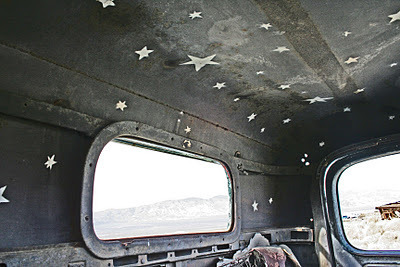
Whatever the truck's provenance, the fact is, once you're walking in Ballarat you're most definitely walking in Charles Manson's footsteps. The family used Ballarat as a gathering point before going deeper into the desert via the Goler Wash to the Barker Ranch where they lived for a time.
Recently, despite not being a Manson obsessive, I'd been wondering if I could make it to the Barker Ranch. I knew the place wasn't in great shape: a couple of years back a fire had destroyed all the wooden parts. I had wondered whether somebody had done this as a kind of ritual cleansing but apparently not. The general wisdom is that somebody stayed there overnight and their propane stove had got out of hand.

The Barker Ranch had become just another cabin available to passing hikers, campers and desert rats - one of quite a few of them in and around Death Valley. They're available on a first come first served basis, and you can imagine that could create problems if some Manson-type was in situ when you arrived.
I also knew that to get there we'd have to drive up the Goler Wash. Online sources, as is the way, told me both that a moderately experienced driver of a 4 x 4 could zip up the Goler Wash without difficulty. Others sources said the route was a serious challenge. Conditions are no doubt changeable.

Rayner Banham said the greatest asset a man can have in the desert is "creative cowardice," and believing this, I drove the miles to the mouth of Goler Canyon, parked, then walked up the wash to see if it looked passable given my admittedly limited skill set as an off-roader.

Now, I'm not saying I couldn't have done it. The canyon walls were narrow, the track was steep, there was water flowing down the wash (it had rained the previous night) but the real problems were some rocky outcrops, described in the literature as steps or falls, places where a vehicle might get grounded or stuck, where you might pop a wheel or a tire, but equally you might not. I thought it was perfectly possible that the Jeep would pass easily over the obstacles, but it seemed perfectly possible that it wouldn't. Being stuck in Goler Wash, quite apart from the risks to self, spouse and vehicle, would have made me look like a complete idiot, something I generally try to avoid.

So we settled for a walk instead. It was a great walk. The canyon's walls were high but not oppressive. The rock was amazing colors. Cactuses grew up the sides, apparently sprouting straight out of the rock. There was also dung at the sides of the track, evidence that there were burros in the area, but we didn't see any of them.
We knew we were never going to walk all the way to the Barker Ranch – it would have been a ten mile round trip – and it was frankly just a burned out cabin. Only later did I read, in this rather wonderful celebratory book that the fire at the Barker Ranch had given the Parks Service an interesting problem. They had contemplated restoring the place, not least to provide accommodation, but I think they feared they could be accused of restoring a Manson shrine, and maybe they also thought some bastard would burn it down again, and so in the end they decided to leave it as it was and it's now officially designated as a "ruin." I rather like that.
As I have said elsewhere, I consider myself a pretty decent walker, but nothing more than that. I don't really think of myself as a true hiker, but Death Valley, makes hikers of us all. And walking there often involves you in some scrambling up rocky slopes, and just occasionally in what the guide books call "canyoneering."
There's a great deal of information available about walking and hiking routes through Death Valley, some of it contradictory or course. The Park Service publishes a sheet listing "day hikes" and they include the Telescope Peak Trail, a 14 mile round trip described as "strenuous." Just for good measure they add, "Climbing this peak in the winter requires ice axe and crampons." I'm pretty sure this doesn't constitute a day hike: I'm absolutely certain it doesn't constitute a walk.

Published on December 19, 2011 09:58
December 4, 2011
FERAL FURNITURE
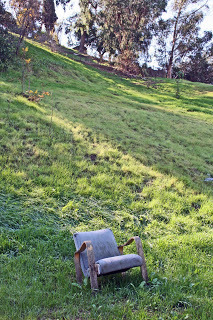
As I was walking through the Corralitas Red Car Property I spotted the above chair, not very close to and apparently not belonging to any house. I wasn't sure whether it had been deliberately put there by someone who thought this was a perfect place to sit, or whether it had simply been dumped and tossed down the hill.
And it struck me, not exactly for the first time, that as I go walking I often see abandoned chairs or sofas, and once in a while I photograph them, though not always. It hasn't quite turned into an art project as yet, though one day it may do.
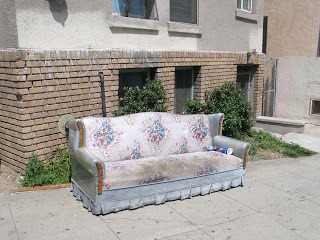
In fact when I went to walk around the chapel that features in the Cabarat Voltaire video of Sensoria, with my pals Steve and Julia, we found a complete three piece suite left on the forecourt of an empty workshop that was up for rent. It struck all of us as pretty funny. How did it get here? It certainly didn't look like the kind of thing that would ever have been inside the workshop. So had somebody gone to the trouble of loading the thing into a van, transporting it here and there placing it on the forecourt? Would it have been any more trouble to take it to the dump?
In Edgelands, a book which I'm still gamely poking around in, the authors (Paul Farley and Michael Symmons Roberts) write, "The feral car seat is another emblem of edgelands. Every childhood should have one. In an age before computer games, sitting in one of these, making engine noises was as close as a child could get to the open road. Or you could strap the seat to a go-cart and find a slope. And you can rock them on their metal runners, survey your empire of feral knotweed, balsam poppies and willow herb like an old hillbilly on a wooden veranda."
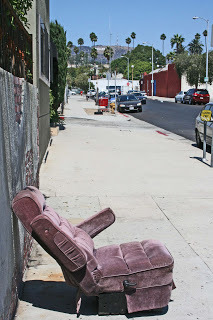
Well yes indeed, though as I've observed before many of the phenomena the boys identify as features of edgelands are present right in the middle of cities. That car seat above was located just off Hollywood Boulevard, outside a marijuana dispensary. The sofa below was on Los Feliz Boulevard, a fairly swanky LA street.

I also see plenty of abandoned televisions and computer monitors when I'm out walking. This is more understandable in many ways: you can't just put them in the trash – the garbage men won't take them. They need to be "recycled." When we bought our new TV the delivery men said they'd gladly take the old one away if we paid them fifty dollars. We decided to save the money and the old TV sits in the junk room and every now and again we think we should do something about it but we never do. Although the "something" thus far has never involved taking it out into the street and leaving at the side of the road.
As a man who does a certain amount of walking in the desert, I do of course come across lots of human jetsom, including this TV.
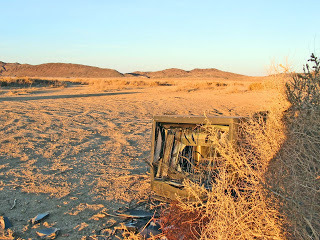
The TV here has been used for target practice, and as an Englishman I find the whole idea of hauling things into the middle of nowhere in order to shoot at them pretty alien, although the evidence is that it strikes many Americans as perfectly standard behavior.

There's a passage in Rayner Banham's "Scenes in America Deserta" where he reckons that people in the desert only shoot manmade things. His observation is that they shoot the hell out of chairs and TVs and road signs, and certainly out of cars, but the things that are native and natural to the desert tend to be left alone. I'm sure this isn't literally true, the odd cactus surely gets shot up, but I do suspect he's on to something.
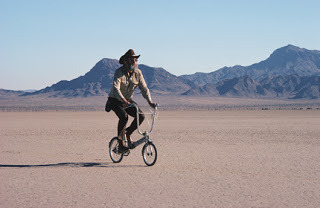
I don't think Banham was much of a walker. All the images I've ever see of him, show him in a car or on one those very cool sixties bikes. These days however there are various "Reyner Banham Loves Los Angeles" tours run by Esotouric, that involve walking as well as bus riding. "Please be prepared to talk a stroll," they say rather gently and plaintively: they're dealing with Angelinos after all.

Published on December 04, 2011 07:23
Geoff Nicholson's Blog
- Geoff Nicholson's profile
- 55 followers
Geoff Nicholson isn't a Goodreads Author
(yet),
but they
do have a blog,
so here are some recent posts imported from
their feed.























